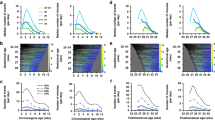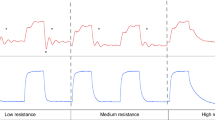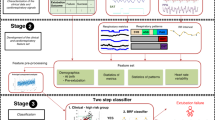Abstract
There is limited data describing how preterm and term infants breathe spontaneously immediately after birth. We studied spontaneously breathing infants ≥29 wk immediately after birth. Airway flow and tidal volume were measured for 90 s using a hot wire anemometer attached to a facemask. Twelve preterm and 13 term infants had recordings suitable for analysis. The median (interquartile range) proportion of expiratory braking was very high in both groups (preterm 90 [74–99] vs. term 87 [74–94]%; NS). Crying pattern was the predominant breathing pattern for both groups (62 [36–77]% vs. 64 [46–79]%; NS). Preterm infants showed a higher incidence of expiratory hold pattern (9 [4–17]% vs. 2 [0–6]%; p = 0.02). Both groups had large tidal volumes (6.7 [3.9] vs. 6.5 [4.1] mL/kg), high peak inspiratory flows (5.7 [3.8] vs. 8.0 [5] L/min), lower peak expiratory flow (3.6 [2.4] vs. 4.8 [3.2] L/min), short inspiration time (0.31 [0.13] vs. 0.32 [0.16] s) and long expiration time (0.93 [0.64] vs. 1.14 [0.86] s). Directly after birth, both preterm and term infants frequently brake their expiration, mostly by crying. Preterm infants use significantly more expiratory breath holds to defend their lung volume.
Similar content being viewed by others
Log in or create a free account to read this content
Gain free access to this article, as well as selected content from this journal and more on nature.com
or
Abbreviations
- FRC:
-
functional residual capacity
References
Karlberg P, Koch G 1962 Respiratory studies in newborn infants. III. Development of mechanics of breathing during the first week of life. A longitudinal study. Acta Paediatr Suppl 135: 121–129
Karlberg P 1960 The adaptive changes in the immediate postnatal period, with particular reference to respiration. J Pediatr 56: 585–604
Milner AD, Sauders RA 1977 Pressure and volume changes during the first breath of human neonates. Arch Dis Child 52: 918–924
Vyas H, Milner AD, Hopkins IE 1981 Intrathoracic pressure and volume changes during the spontaneous onset of respiration in babies born by cesarean section and by vaginal delivery. J Pediatr 99: 787–791
Vyas H, Milner AD, Hopkin IE, Falconer AD 1983 Role of labour in the establishment of functional residual capacity at birth. Arch Dis Child 58: 512–517
Vyas H, Field D, Milner AD, Hopkin IE 1986 Determinants of the first inspiratory volume and functional residual capacity at birth. Pediatr Pulmonol 2: 189–193
Mortola JP, Fisher JT, Smith JB, Fox GS, Weeks S, Willis D 1982 Onset of respiration in infants delivered by cesarean section. J Appl Physiol 52: 716–724
Saunders RA, Milner AD 1978 Pulmonary pressure/volume relationships during the last phase of delivery and the first postnatal breaths in human subjects. J Pediatr 93: 667–673
Mortola JP, Fisher JT, Smith B, Fox G, Weeks S 1982 Dynamics of breathing in infants. J Appl Physiol 52: 1209–1215
Frappell PB, MacFarlane PM 2005 Development of mechanics and pulmonary reflexes. Respir Physiol Neurobiol 149: 143–154
Fisher JT, Mortola JP, Smith JB, Fox GS, Weeks S 1982 Respiration in newborns: development of the control of breathing. Am Rev Respir Dis 125: 650–657
Kosch PC, Stark AR 1984 Dynamic maintenance of end-expiratory lung volume in full-term infants. J Appl Physiol 57: 1126–1133
Lindroth M, Johnson B, Ahlstrom H, Svenningsen NW 1981 Pulmonary mechanics in early infancy. Subclinical grunting in low-birth-weight infants. Pediatr Res 15: 979–984
Mortola JP, Milic-Emili J, Noworaj A, Smith B, Fox G, Weeks S 1984 Muscle pressure and flow during expiration in infants. Am Rev Respir Dis 129: 49–53
Radvanyi-Bouvet MF, Monset-Couchard M, Morel-Kahn F, Vicente G, Dreyfus-Brisac C 1982 Expiratory patterns during sleep in normal full-term and premature neonates. Biol Neonate 41: 74–84
Bolt RJ, van Weissenbruch MM, Lafeber HN, Delemarre-van de Waal HA 2001 Glucocorticoids and lung development in the fetus and preterm infant. Pediatr Pulmonol 32: 76–91
Jain L, Eaton DC 2006 Physiology of fetal lung fluid clearance and the effect of labor. Semin Perinatol 30: 34–43
Aly H, Massaro AN, Patel K, El Mohandes AA 2005 Is it safer to intubate premature infants in the delivery room?. Pediatrics 115: 1660–1665
Thomson MA 2002 Continuous positive airway pressure and surfactant; combined data from animal experiments and clinical trials. Biol Neonate 81: 16–19
Morley CJ, Davis PG, Doyle LW, Brion LP, Hascoet JM, Carlin JB 2008 Nasal CPAP or intubation at birth for very preterm infants. N Engl J Med 358: 700–708
Gerhardt T, Bancalari E 1980 Chestwall compliance in full-term and premature infants. Acta Paediatr Scand 69: 359–364
Heldt GP, McIlroy MB 1987 Dynamics of chest wall in preterm infants. J Appl Physiol 62: 170–174
Barker PM, Gowen CW, Lawson EE, Knowles MR 1997 Decreased sodium ion absorption across nasal epithelium of very premature infants with respiratory distress syndrome. J Pediatr 130: 373–377
Zelenina M, Zelenin S, Aperia A 2005 Water channels (aquaporins) and their role for postnatal adaptation. Pediatr Res 57: 47R–53R
Plakk P, Liik P, Kingisepp PH 1998 Hot-wire anemometer for spirography. Med Biol Eng Comput 36: 17–21
Marsh MJ, Ingram D, Milner AD 1993 The effect of instrumental dead space on measurement of breathing pattern and pulmonary mechanics in the newborn. Pediatr Pulmonol 16: 316–322
Morris MG 1999 A simple new technique to measure the effective dead space of the face mask with a water volumeter in infants. Eur Respir J 14: 1163–1166
Morley C 2007 New Australian Neonatal Resuscitation Guidelines. J Paediatr Child Health 43: 6–8
Stick S 1996 Measurements during tidal breathing. In: Stocks J, Sly PD, Tepper RS, Morgan WJ (eds) Infant Respiratory Function Testing. John Wiley & Sons Inc, New York, pp 118–119
Karlberg P, Cherry RB, Escardo FE, Koch G 1962 Pulmonary ventilation and mechanics of breathing in the first minutes of life, including the onset of respiration. Acta Paediatr 51: 121–136
Engstrom L, Karlberg P, Rooth G, Tunell R 1966 The Onset of Respiration: A Study of Respiration and Changes in Blood Gases and Acid-base Balance. Association for the aid of crippled children,. New York, pp 17–23
Lopes J, Muller NL, Bryan MH, Bryan AC 1981 Importance of inspiratory muscle tone in maintenance of FRC in the newborn. J Appl Physiol 51: 830–834
Stark AR, Cohlan BA, Waggener TB, Frantz ID III, Kosch PC 1987 Regulation of end-expiratory lung volume during sleep in premature infants. J Appl Physiol 62: 1117–1123
Milner AD, Saunders RA, Hopkin IE 1978 Is air trapping important in the maintenance of the functional residual capacity in the hours after birth?. Early Hum Dev 2: 97–105
Mortola JP, Magnante D, Saetta M 1985 Expiratory pattern of newborn mammals. J Appl Physiol 58: 528–533
Long EC, Hull WE 1961 Respiratory volume-flow in the crying newborn infant. Pediatrics 27: 373–377
Stocks J 1999 Lung function testing in infants. Pediatr Pulmonol Suppl 18: 14–20
Schmalisch G, Foitzik B, Wauer RR, Stocks J 2001 Effect of apparatus dead space on breathing parameters in newborns: “flow-through” versus conventional techniques. Eur Respir J 17: 108–114
Fleming PJ, Levine MR, Goncalves A 1982 Changes in respiratory pattern resulting from the use of a facemask to record respiration in newborn infants. Pediatr Res 16: 1031–1034
Dolfin T, Duffty P, Wilkes D, England S, Bryan H 1983 Effects of a face mask and pneumotachograph on breathing in sleeping infants. Am Rev Respir Dis 128: 977–979
Author information
Authors and Affiliations
Corresponding author
Rights and permissions
About this article
Cite this article
te Pas, A., Wong, C., Kamlin, C. et al. Breathing Patterns in Preterm and Term Infants Immediately After Birth. Pediatr Res 65, 352–356 (2009). https://doi.org/10.1203/PDR.0b013e318193f117
Received:
Accepted:
Issue date:
DOI: https://doi.org/10.1203/PDR.0b013e318193f117
This article is cited by
-
Tidal volumes during delivery room stabilization of (near) term infants
BMC Pediatrics (2022)
-
Contactless radar-based breathing monitoring of premature infants in the neonatal intensive care unit
Scientific Reports (2022)
-
The DELUX study: development of lung volumes during extubation of preterm infants
Pediatric Research (2022)
-
Aerosol drug delivery to spontaneously-breathing preterm neonates: lessons learned
Respiratory Research (2021)
-
Recent Advances in Pathophysiology and Management of Transient Tachypnea of Newborn
Journal of Perinatology (2021)



